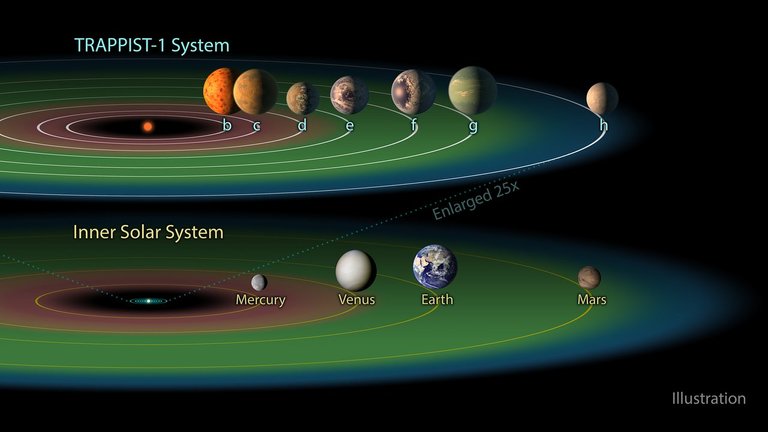
Source
Although it may seem incredible to you, 100 years ago the most experienced astronomers thought that the entire universe was reduced to the Milky Way, it was not until the 20s of the last century that Edwin Hubble (who was a gentleman before being a telescope), discovered that some of the bright spots were other very distant galaxies as big as our own and even much larger.
Aunque os parezca increíble, hace 100 años los astrónomos más avezados pensaban que todo el universo se reducía a la Vía Láctea, no fue hasta los años 20 del siglo pasado que Edwin Hubble (que antes de ser un telescopio era un señor ), descubrió que algunos de los puntos luminosos eran otras galaxias muy lejanas tan grandes como la nuestra e incluso mucho más.
Studying our solar system it seemed clear that if there were other stars similar to the Sun they would also have to have their own planets orbiting them, which they called exoplanets, but exoplanets do not emit light so they are difficult to detect, in fact the first one is not discovered until 1992.
Estudiando nuestro sistema solar parecía evidente que, si había otras estrellas similares al Sol éstas tendrían que tener también sus propios planetas orbitándolas a los que llamaron exoplanetas, pero los exoplanetas no emiten luz por lo que son difíciles de detectar, de hecho el primero no se descubrió hasta 1992.

Source
To locate these exoplanets, two different techniques are used, one by detecting stellar wobble, that is, the movement of the star due to the gravitational pull of the planet, an effect similar to that produced in hammer throwing athletes, the other method It consists of measuring the decrease in brightness of the star when a planet passes in front of it.
Para localizar estos exoplanetas se utilizan dos técnicas diferentes, uno mediante la detección del bamboleo estelar, es decir, el movimiento de la estrella debido al tirón gravitacional del planeta, un efecto similar al que se produce en los atletas lanzadores de martillo, el otro método consiste en medir el descenso de brillo de la estrella cuando un planeta pasa por delante de ella.
Obviously, all this is done with the use of specialized telescopes such as the TESS (Transiting Exoplanet Survey Satellite) or the Kepler telescope which, in the last 30 years, have discovered up to 5,000 exoplanets using these methods, as NASA has recently confirmed.
Obviamente todo esto se realiza con el uso de telescopios especializados como el TESS (Transiting Exoplanet Survey Satellite) o el telescopio Kepler que, en estos últimos 30 años han llegado ha descubrir hasta 5.000 exoplanetas utilizando estos métodos según ha confirmado recientemente la NASA.

Source
As you can imagine, among these 5,000 planets they have found everything, gaseous planets much larger than Jupiter, incandescent planets where rivers of lava flow or where it rains iron or diamonds and of course, rocky planets like the Earth of the same size and several times larger in which some form of life could possibly be found.
Como podréis imaginar entre estos 5.000 planetas han encontrado de todo, planetas gaseosos mucho mayores que júpiter, planetas incandescentes donde fluyen ríos de lava o donde llueve hierro o diamantes y por supuesto, planetas rocosos como la Tierra del mismo tamaño y varias veces mayores en los que posiblemente se pudiera hallar alguna forma de vida.
According to experts, in the Milky Way alone there could be 6,000 million planets similar to Earth, that is, rocky planets of similar size that orbit stars with the characteristics of the Sun at a distance that allows the existence of liquid water.
Según los expertos, tan solo en la Vía Láctea podría haber 6.000 millones de planetas similares a la Tierra, es decir, planetas rocosos de tamaño similar que orbitan estrellas de las características del Sol a una distancia tal que permita la existencia de agua líquida.
Although it is good to be optimistic, this in itself does not mean that there is life and much less intelligent life (which there is not much on Earth either) in addition, the closest of all of them would be orbiting Alpha-Centauri 4 light years away (about 40 billion km).
Aunque es bueno ser optimistas esto en sí mismo no quiere decir que haya vida y mucho menos inteligente (que tampoco hay mucha en la Tierra) además, el más cercano de todos ellos estaría orbitando Alfa-Centauri a 4 años luz de distancia (unos 40 billones de km).
More information/Más información
https://www.jpl.nasa.gov/news/cosmic-milestone-nasa-confirms-5000-exoplanets
Hola @mauromar, eso es asombroso que existan tantos.
☺☺☺
I liked how u said Hubble was a gent before becoming a telescope. :P and the stellar wobble is so smart..
Do you think that these discovered planets will be exploited in terms of their riches. Or is it just useless discoveries?
Maybe in a thousand years...